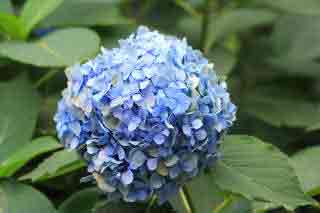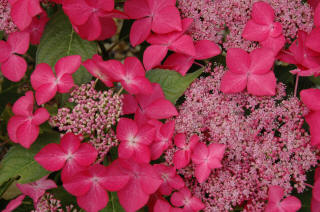Hydrangeas in the Garden - How to Grow.
Hydrangeas are one of the most popular of all garden shrubs with
very showy flowers and large attractive leaves. The fact that
they are so very easy to grow, adaptable to most soil and garden
situations, makes them the ideal choice for inclusion in a shrub
bed or border. They can also be featured as a stand-alone
specimen in the middle of a lawn bed. Hydrangeas also make good
container plants. There is also a good climbing version of the
Hydrangea family.
Florists also make good use of Hydrangeas as potted houseplants. These
are the same as the garden hydrangeas, but grown differently.
After use indoors, they can be
planted out in the garden or outside container.
The ease of growing Hydrangeas is highlighted by the
rarity of help questions my mailbox. It is one of the easiest and
rewarding of shrub with very few problems. The main question I get for
help advice, is how to turn the flowers blue!
 Hydrangeas can be conveniently split into a few groups – all of the
plants in each group being happy with the same cultural requirements –
One size fits all – almost!
Hydrangeas can be conveniently split into a few groups – all of the
plants in each group being happy with the same cultural requirements –
One size fits all – almost!
Hydrangea Types
The main garden Hydrangea shrubs are within the Hydrangea
macrophylla group. Hydrangea macrophylla types are split into the
common mop-head types or Lace-Caps.
Mophead Hydrangeas
The
Mopheads – generally classed as ‘Hortensia Hydrangeas’ have round
globular blooms of varying sizes, which are made up of masses of
smaller florets. The individual florets are male – therefore not
fertile – and are blessed with the groups wide range of colors
ranging from pure white, through light pink to deep red. There are
also some violet/purple types. The much sought-after blue flowers
are also in the is group – of which, more below!
Some of the Mophead Hydrangeas are almost as big as a football, but
generally around 4-6in across (10-15cm).
Lacecap Hydrangeas
 The
Lacecap group of Hydrangea macrophylla has flat blooms with the
outer surrounds of showy florets - which are the fertile female
flowers – giving them the worthy description of ‘Lacecaps’. These
female florets surround the central cluster of the smaller male
flowers – for obvious reasons!
The
Lacecap group of Hydrangea macrophylla has flat blooms with the
outer surrounds of showy florets - which are the fertile female
flowers – giving them the worthy description of ‘Lacecaps’. These
female florets surround the central cluster of the smaller male
flowers – for obvious reasons!
The flower range is as with the Mopheads, but with some interesting
bi-colour effects brought about by the difference in some, of the
female and male flowers; the darker centre being normally surrounded
by the lighter coloured female flowers.
Growing Conditions and Requirements
Both Mophead and Lacecap types within the H. macrophylla group have
the same cultural requirements. Full sun is perfect, with dappled
shade coming also acceptable. Though they prefer a slightly moist
soil, I have seen and photographed many fine specimens in dry soil
areas.
They are happy in a wide range of soil types – other than heavy clay
– but do best in a fertile, well drained soil that does not become
waterlogged in winter. Annual mulching of organic material is
beneficial, both for general plant health, but also because it will
help to regulate the soil’s ph level. High lime content – such as on
chalky soils – or near and old wall that had lime mortar, will
probably lead to a lightening of leaf colour which signifies like
induced chlorosis. It will be virtually impossible to grow for the
desired blue flowers in this situation.
These Hydrangeas are reasonably tolerant of dry weather conditions, but do tend to look rather sorry for themselves with their drooping leaves in the driest conditions. Drooping foliage is also apparent on hot sunny days. Apply a much to keep the soils as moist as possible. Give a good soaking around the root zone - not spray all over the foliage or flowers
Other Mopheads and Lacecap Hydrangeas.
There are several other Hydrangeas that can lay claim to either being Mophead or Lacecap. Two of such would find their way into any garden of mine, conveniently being one of each.
Hydrangea preziosa would fill the gap as far at Mopheads are concerned, with its bright deepest pink flowers – nay, red - as a basis, but planted in a non alkaline soil, the flower colour can be mauve or varied shades of blue. Upright growing, but very ‘dapper’, it is great in a container!
Hydrangea villosa just about makes it as a lacecap with somewhat sparse surround of florets. Slightly spreading – unless pruned otherwise – it has narrow lance like leaves - very smooth and velvet textured - which are good contrast to the blue-purple inner flower head which resembles an upturned broccoli head – but much more decorative. Great contrast on the flowerhead with white florets surrounding in contrast to the purple. It is later flowering than most on this page, so just in time to brighten up our early winter.
Attractive flaked Bark.
Over the years I have had requests for help in diagnosing a a ‘disease’ affecting Hydrangea stems. The bark positively flakes like brown tissue paper on some varieties. Not a disease; it happens – especially on older un-pruned stems.
Not all varieties have this added attraction, so will be outlined in the accompanying lists.
How to Turn Hydrangeas Blue - Applies only to Hydrangea macrophylla types. (This page describes)
Pruning Hydrangea macrophylla - Mopheads and Lacecaps.
Pruning Hydrangea Paniculata types - also H. Arborescens.
Propagating Hydrangeas
Hydrangeas in Containers
Problems with Hydrangeas
List of Hydrangeas
Best Selling Gardening Products
Popular Gardening Sections

Problems
Identify Weeds in The Garden - How to deal with weeds. Diseases and Pest which harm your garden and plants, learn how to prevent, deter and erradicate your garden problems.
Garden Problems
Pruning
Pruning Guide. Shrubs flower better with correct pruning. Many illustrations and examples of what to do - and when. Includes evergreens, roses, flowering shrubs, spring flowering shrubs and pruning for stem effect. This is our most viewed and comprehensive section,
Pruning
Gardening Businesses
Gardening Businesses listed in the UK counties and USA states. County and State Listings of businesses involved in Garden supplies and services. If you wish to be added to the Directory, please send us your information. Having problems, use the search box
Businesses
Gardening
In this section you will learn about Gardening Basics, Containers, Landscaping, Propagation and Soil.
Gardening
Gardening Gifts
Gardening Gifts and Reviews, Read Before you Buy
- Gardening Gifts Ideas
- Gifts For Her
- Gifts For Men
- Power Tool Gifts
- Cheap Gifts
- Personalised Gifts
- Wildlife Gifts
- Family Gifts



